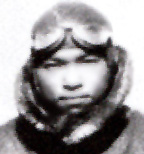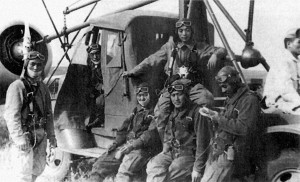
Published June 22, 2012
“How many enemy aircraft there were; but we have courage, like eagles pursuing swallows, and we overwhelmed the enemy. About 5:30 pm, I spotted 25-26 more flying at about 2,000 meters — on the first pass, one was going down in flames and one by one others went down in the same way. More new enemy aircraft appeared and entered the battle — they were all around — we left the area of the fighting and returned. There were many hits to the wings and tail of my aircraft.” Those were the words of Captain Saiji Kani, the leader of the 1st Chutai, who scored five kills in the battle.
On this date in 1939, one of the largest air battles of the early stages of World War II was fought in the skies over Mongolia, pitting Soviet aircraft against the Japanese. Years before, Japan had invaded mainland China and Indochina and had occupied huge swaths of territory. In the northwest, the fighting raged along the flat grasslands of Mongolia. In May of 1939, the Soviets deployed additional forces and a major conflict broke out near the village of Nomonhan in Mongolia. In June, the forces met in what would become known as the Khalkhin Gol Incident (named after the river the runs through the battle area).
Air power would play a surprisingly important role in the battle, given the barren, flat grasslands terrain which favored close air support. The fight for air superiority would match Japanese Ki-27 light fighters against Russian I-15s and I-16s. On the eve of the battle, four Soviet aviation regiments were at the front. Two were fighter units — the 70th Fighter Regiment had 60 I-16 fighters and 24 I-15bis (I-152) fighter planes while the 22nd Fighter Regiment had 35 I-16 fighters and 32 I-15bis (I-152) fighter planes. In addition, the Soviets fielded two bomber units. On the Japanese side, the order of battle was composed of approximately 75 to 100 Ki-27s (later code-named the “Nate” by the Allied forces), among a mix of other aircraft including bombers and reconnaissance types.

On June 22, 1939, the largest engagement was fought, lasting two and a half hours of a running battle that pitted the entire fighter forces of both nations against one another in the skies. The Japanese were outnumbered, but made up for their lack of numbers through valiant deeds and courage, willingly throwing themselves back into battle over and over again, despite damage to their aircraft. The total aircraft shot down remains disputed to this day with both sides claiming many more than records support. The Japanese claim that three of their pilots became aces that day, downing five each. Others scored as well, including Hiromichi Shinohara, who would become known as the “Richthofen of the Orient.” Emboldened, the Japanese launched a follow-up air attack on June 27th. Once again, their pilots reported great success — among them, Hiromichi Shinohara once again made claims and was credited with 11 kills that day in combat over Tamsak-Bulak. The results of the conflict were that the two sides were now in a stalemate on the ground.
Under orders to finish the campaign so that Stalin could refocus exclusively on Europe, Soviet General Georgy Zhukov (who would later lead the Soviet Army against the Germans at Stalingrad) amassed a large ground and air force during August, supporting them with a truck route that involved over 2,600 trucks. His army numbered over 57,000 men, supported by 557 aircraft. On August 24, their force somehow undetected by the Japanese, the Soviets launched a surprise offensive. It would prove to be the decisive battle of the campaign, driving the Japanese completely out of Soviet Manchuria with an overwhelming victory.

For the Japanese pilots, the experiences at Khalkhin Gol had a major psychological impact. The top ace of the IJAAS (Imperial Japanese Army Air Service), Hiromichi Shinohara, was killed in the final defense effort on August 27. By then, he had amassed a record of 58 kills, despite having been in combat for just three months. His example would go on to inspire Japanese pilots for the remainder of the war. Future Japanese pilots would rely on individual courage and technique to attain victory, even when faced with superior numbers — it was the birth of the ideal of the Japanese fighter pilot as a modern samurai. For the Soviets, Khalkhin Gol was the opposite lesson. It was their first military assault that integrated both air and ground forces — this would become a model that would serve the Soviets for the rest of the war. For their part, they learned that individual heroism mattered less than the combined brunt force of an overwhelmingly large ground force integrated with close air support.
The Japanese lessons of Khalkhin Gol would lead them (at least in part) to defeat in World War II, while the Soviet lessons would lead them to victory in Europe and laid the foundation of Soviet military strategy and policy throughout the Cold War era that followed.
One More Bit of Aviation Trivia
Hiromichi Shinohara’s record of 11 kills in one day is extraordinary, but it is not the highest record in aviation history. Four other pilots, all from the Luftwaffe during World War II, would exceed Shinohara, some several times — Erich Hartmann (12 kills in a single day on the Eastern Front), Hans-Joachim Marseille (17 in North Africa); and Erich Rudorffer (13 kills in 17 minutes on one of three occasions that he exceeded Shinohara’s one day record, all on the Eastern Front); and Emil Lang (who exceeded the record twice, scoring 12 kills on October 21, 1943, and later another 18 aircraft on November 3, 1943, both records set on the Eastern Front).

Hi, I’m doing a paper on Khalkhin Gol and want to include a section about how the Soviet Air Force gained experience and changes from the battle. Your article is very well flushed out, and I just wanted to ask about your sources of data?